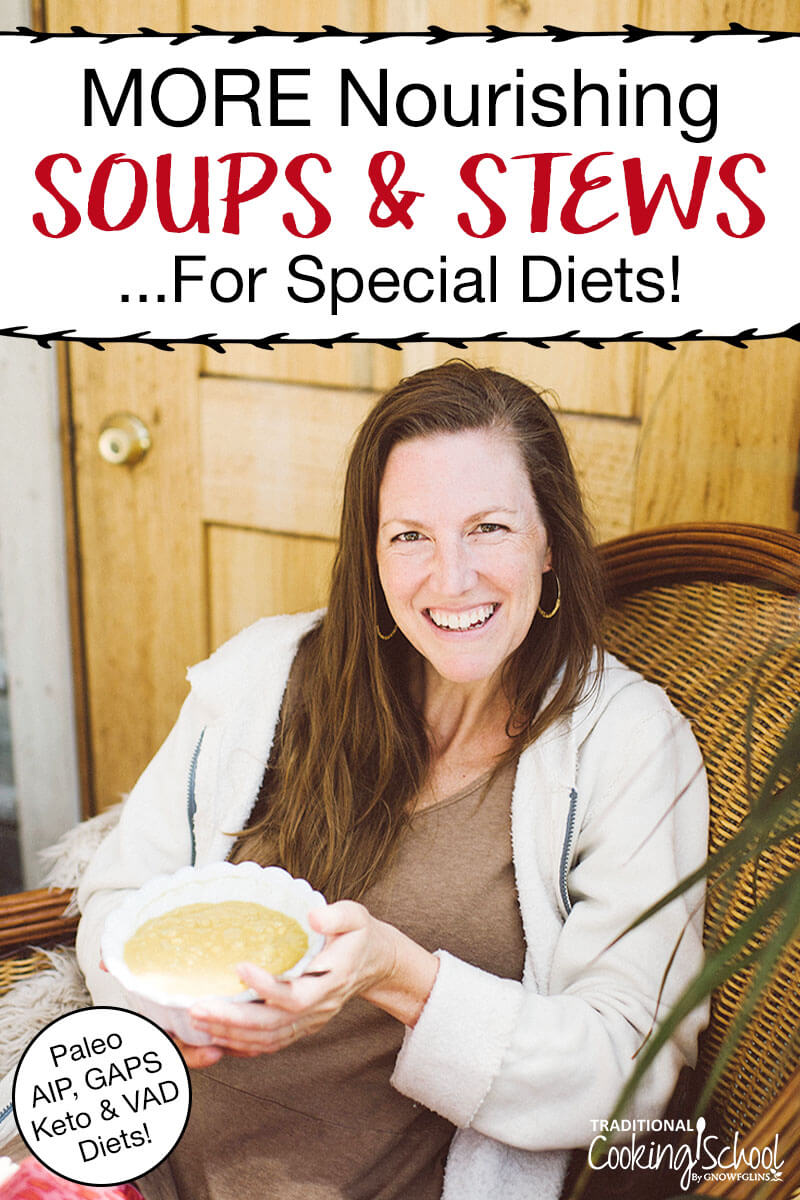
If you’re on a special diet like Paleo, AIP, Keto, GAPS (or GAPS Intro), or VAD, then you know it can get boring.
You feel like you’re just eating the same old soup day after day, right?
Pretty soon the kids and husband start rebelling with “Not soup AGAIN?” It can get so discouraging!
Yet… what if I told you there are simple ways (and easy recipes) that will step up your soup-making, making your meals not only as nutritious as can be, yet also with practically limitless variety? In other words, all the nutrition without the soup boredom!
There is a way! And the brand-new cookbook, Eat Beautiful, Secrets from a Bone Broth Kitchen, Soups and Stews for Your Wellness Diet from my dear friend Megan Stevens, holds the keys…
Actually 7 of them, because the cookbook contains 7 soup-making secrets that ensure your soups are extra nourishing and never boring! Also many use the Instant Pot and are quick and easy!
I recently sat down with Megan to chat about her brand-new cookbook… so you could get to know her if you don’t already, and to share more information about her brand-new, beautiful cookbook.
Watch the video (or read the transcript below) to get the full scoop! And be sure to order your e-copy right here for 57% OFF!
Enjoy!
Video: More Nourishing Soups & Stews Interview with Megan (29:24)
Transcript: More Nourishing Soups & Stews Interview
Wardee: Hi, everyone. I’m Wardee from Traditional Cooking School here with my dear friend, Megan Stevens. Hi, Megan.
Megan: Hi, Wardee.
Wardee: We are so excited because, Megan, let’s do this at the same time. Let’s both hold up what we’ve got.
Megan: One, two, three.
Wardee: Yeah, look, yay, we are holding proof copies of Megan’s brand new cookbook.
As you might know, Megan, from Eat Beautiful, she’s already had one book for healing diets, and this one is solely focused on amazing soups and stews, and it’s so beautiful. Congratulations, Megan.
Megan: Thank you. I appreciate it.
Wardee: The whole title is Eat Beautiful, Secrets from a Bone Broth Kitchen, Soups and Stews for Your Wellness Diet, and it has 80 Paleo, AIP, GAPS, GAPS intro, Keto, and VAD, which is vitamin A detox. Correct?
Megan: Mm-hmm (affirmative). That’s right. Yep.
Wardee: It has over 80 recipes for all those diets, soups and stews, so it’s just beautiful, and we’re having this little podcast/interview video chat today to talk about Megan’s book and, for those of you who don’t know Megan, to get to know her better. Exciting.
Megan: Yes. Thank you, and all of the recipes are ancestral or traditional, so, even if someone is gluten-free or doesn’t recognize one of those recipe or categories of a diet, this is really meant for a traditional cooking audience.
Wardee: Perfect. I’m glad you said that, so let’s talk about you and your family first so people who don’t know yet can get to know you a little bit, so let’s start with that.
Megan: Okay. Great, so my husband and I have been married about 25 years, and we have three kids. We’re in the process of adopting our fourth. We have an 18-year-old, a 16-year-old, and a 10-year-old. The oldest is a girl, and then two boys, and we expect to be adopting a daughter, who’s going to be probably two.
I had a lot of antibiotics when I was a kid, and so all of my kids were born with autoimmune diseases of one kind or another, and so that launched us into… We were already eating an ancestral diet, but it segued us into the GAPS diet, which we did for about six years, and that was about 10 years ago.
After GAPS, we segued into some other wellness diets to continue to work and hone on some of the health issues we were continuing to deal with.
During that process, some of you are already aware of this, we opened a café that was a kefir-based and non-dairy frozen yogurt shop. Everything was homemade, but during that process is when my health started to deteriorate.
Then we started and transitioned into a bone broth and soup café, and so that became a big part of our life for about eight years. Now, we’ve transitioned out of that as we begin to move towards adoption, but that was definitely a big part of our family for many, many years.
Wardee: I know. It’s hard to believe it’s been so long.
Megan and I have been friends since college, and we lived in the same area of Oregon at the time. I just can’t believe it’s been eight years since you were opening and expanding your cafe. Wow, and now you’re out of it.
Megan: Yes. Yes. It was a lot. It was a lot to own a brick-and-mortar restaurant.
Wardee: It’s such a lot of work, so would you say moving on from it has been a good chapter in your healing as well, just because of the stress and the work involved?
Megan: Exactly. Yeah, so I feel like, the first three years, they were almost poetry for me. It was just delightful to mix that kefir and to make the bone broth. It was really exciting.
After a while, it took its toll on our family. It was tiring. The hours were long, and so, yeah, largely for my health, we stepped back just because we needed more downtime as a family at home.
Wardee: Mm-hmm (affirmative), but you’re so gifted with food. Megan and her family, even though they’ve been on special diets all these years and experienced all this healing, they’re always feasting and eating beautiful, thus, Eat Beautiful.
Megan doesn’t do it in her brick-and-mortar shop anymore. She does it for her blog and her books, and the photography in here is just gorgeous, so I can’t wait till we talk about the recipes more.
Megan: Thank you.
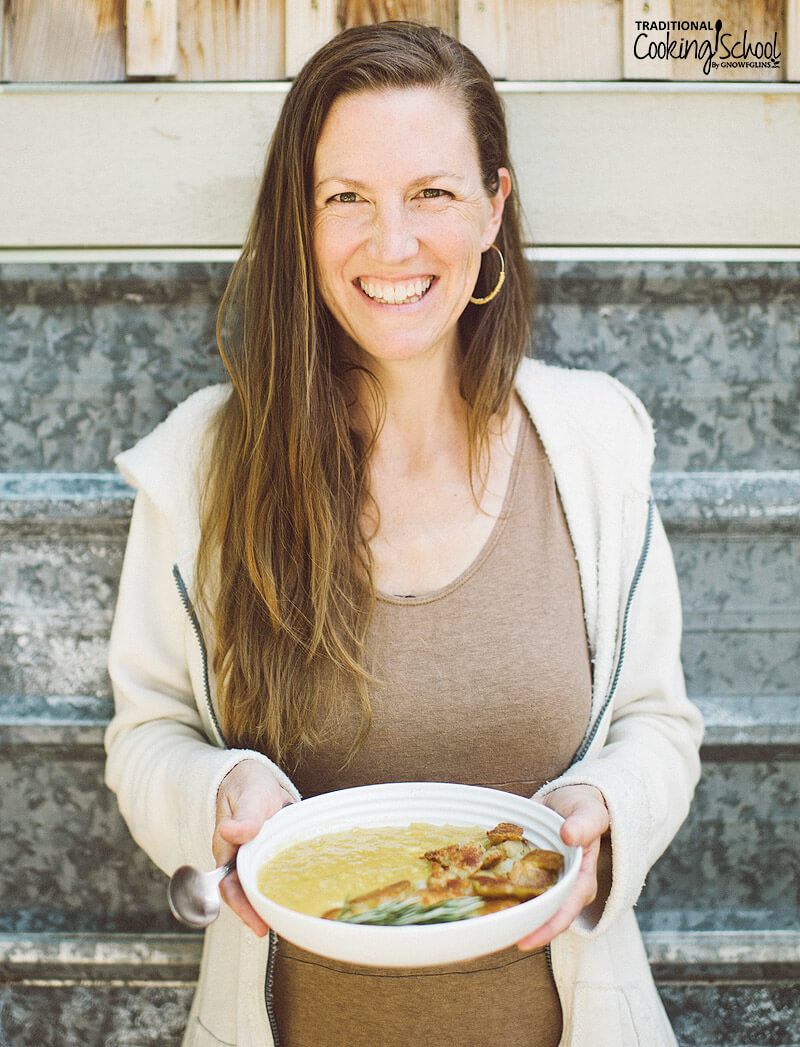
Wardee: Tell us now about the book, more specifically, why did you write it, what’s in it, stuff like that.
Megan: Sure. While we owned the café, I was also teaching Weston A. Price Foundation cooking classes, not sponsored by them, but just ancestral or traditional techniques.
I was meeting a lot of people in the community, and I also started a nutritional consulting business at that time because a lot of customers were coming up to me and saying, “Can you help me? Can you teach me how to integrate recipes into our home that will support my health?”
That became a very joyful part of my life to help people one-on-one.
We had more and more customers asking for the recipes, so I said, “Okay, I’ll start writing a soup cookbook.”
I did not know it would take me three years to write it, and that’s how long it took me just because we were still running the business, still homeschooling, still raising our children.
Every once in a while, I have customers who I’d see in town and they’d ask, “Where is your soup cookbook? Is it still coming?” I’d say, “Yes, it’s still coming.”
Amazingly, it is actually here now.
That’s why I wrote it. I wrote it because people asked for it, and I could tell they needed it. I wanted to be able to provide great soup recipes that were easy and taught the secrets of why and how do you make a great soup, especially for wellness diets where people didn’t know how to make amazing soups.
When we were first on the GAPS diet, our soups were not delicious. My kids and I were just getting through.
The second time we went through the GAPS intro diet, I was making these delicious soups, and it was this epiphany of, “Oh, my goodness, I wish I had known how to do this the first time through!” The customers at our café I think felt the same way, like, “How do you make your soups taste like this?”
I had to learn the secrets myself, and so this cookbook teaches those ideas and principles as well as actual amazing soup recipes!
Wardee: Mm-hmm (affirmative), wonderful. I know a lot of you are probably like, “Where do I find it?” We’re going to continue talking about it, but you can actually start reading about it now, but pause the video, and then come back and pick up where you left off. It’s tradcookschool.com/soupsandstews, where soups and stews is all one word.
Okay, Megan, now let’s talk about who this book is for. Maybe you could talk a little bit about the diets and just the kinds of reasons somebody might need to pick this up.
Megan: Sure, so, specifically, on the cover and within the cookbook, I’ve designated the different diets. So, Paleo, AIP, which is autoimmune protocol, which is the offshoot of the Paleo diet to put autoimmune diseases into remission, GAPS, GAPS intro, the ketogenic diet and then VAD, which is the vitamin A detox diet.
VAD is a newer remedial diet that isn’t as well-known, but our family is doing that diet right now.
There are several recipes that overlap where you could be on any of these diets and make those recipes, which is really neat, and then, in other cases, if you come to this cookbook and say, “Hey, I’m on the AIP diet. I need just AIP recipes,” there’s an index in the back that has just the AIP recipes and you can actually, using the eCookbook, you can just click on a page. It’ll link you right to that recipe, and those are going to be very safe and designed for that specific diet.
The other neat thing about the cookbook is a lot of you are like me, which is that sometimes you’ll do a certain diet for six months, nine months, a year, two years, and then you’ll say to yourself, “You know what, I’ve made I think all the progress I can make on this diet. I’d really like to see if this other diet has some benefits for my body. I’d love to try it out. Oh, wait, cool, this recipe book has recipes for that diet as well. I’m going to just switch over and try the keto diet for six months.”
It allows you to switch from one diet to another. It allows you to cook for a family that has different dietary needs, and then all of the recipes are truly delicious, so you can even cook for guests out of this cookbook, be on your wellness diet, and they won’t know they’re eating healing food.
It’ll taste amazing and they’ll love it, so it’s really… It’s supposed to be very specific, but also meet some broad needs.
Wardee: I love, and, of course, you and I talked about it as you were doing the outline and how do I organize this, but I really love the way that you’ve organized it. You’ve made it really easy for people to know just at a glance if a recipe meets their needs or not. I know you spent hours on making sure it’s very, very usable.
Megan: Yes. Yes, I sure did.
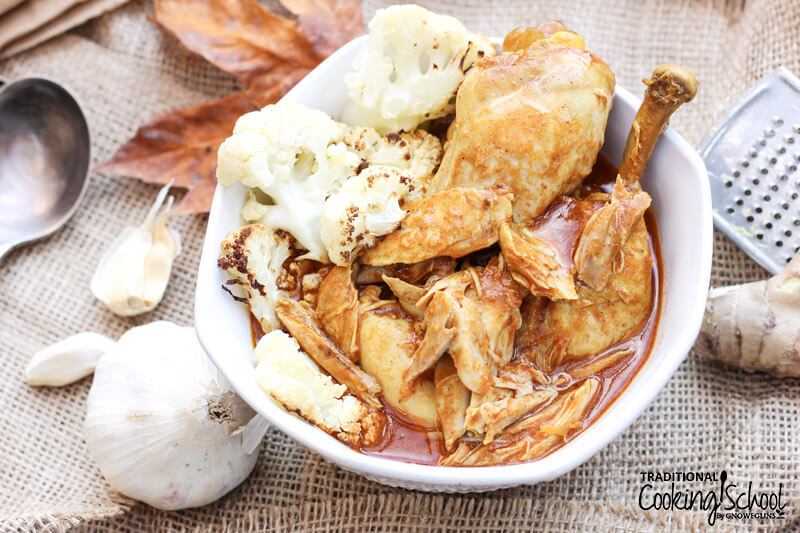
Wardee: Is there anything else you wanted to add on who’s the cookbook for or how it’s organized?
Megan: I think maybe just to clarify that I understand, when someone’s on a wellness diet, the protocol is very strict, and so I definitely went and did this cookbook with that in my mind’s eye, that this needs to meet the needs of someone who either doesn’t necessarily know what the protocol is or is very stringent about the protocol and needs to make sure that I am as well, so I was really careful with the details of this cookbook.
Then also I really want this to be for anyone who just needs to have convenience in their life, who just wants to learn how to make amazing soups or even a gourmet who’s like, “I just want to make great soup, and I’m attracted to this cookbook.”
Great. You can sit down in a cozy chair and just read it and look at it and enjoy it, so really, hopefully, it meets everybody’s needs.
Wardee: Mm-hmm (affirmative), wonderful. Now, talk a little bit about the fact that you used the Instant Pot for some recipes and how that fit in?
Megan: Yeah. Sure. I think we can both agree that’s been a gift to me in my kitchen.
I used to use a Crock Pot. For all of the years we were on GAPS, I used either a stockpot on the stove top or a Crock Pot. It was messy, though.
When the Instant Pot came into my world, I just started using it more and more and more. I didn’t want people to be limited and have to own an Instant Pot to use this cookbook, so there are maybe 25 Instant Pot recipes among the 80.
On the other hand, if you love cooking with your Instant Pot, you’d probably be happy with those 25. That’s actually a lot of recipes, so, yeah, just personally, I find it so much more convenient.
We’re always racing out for basketball practice or a doctor’s appointment or something, and to be able to just put things in there and push go, it just makes our life doable and to come home to such a nourishing meal.
I have a category of recipes in the cookbook called Dump and Cook, and that means you literally just dump everything in there, put on the lid and push the soups-and-stews button and go. There’s no sauteing stage. There’s no browning the meat stage.
Those recipes are specifically designed to taste great as dump-and-cook recipes, whereas other recipes need sauteing or other stages, so, yeah, the Instant Pot is there for those us who really appreciate the convenience, and I should add, as you know, the Instant Pot actually adds a caramelized flavor to certain recipes. I mean it does a great job, so we’re not sacrificing on flavor with those.
Also, I bought my Instant Pot used for like $35. I’m still using the first one I bought, so, if anyone doesn’t have an Instant Pot and isn’t up for buying one, I just want to encourage you to look on Facebook Marketplace or Craigslist, and it doesn’t have to be expensive to get one of those convenient tools in your kitchen.
Wardee: Yep, and I will be sure to include a link to an Instant Pot with this video, so just look with it, as well as links to Megan’s cookbook.
For anybody that doesn’t know what an Instant Pot is, it’s an electric multi-cooker, and by that I mean you plug it in and it has all these settings. A slow cooker setting, pressure cooking settings…
It also has programmed buttons like the soups-and-stews button that Megan was just talking about where you set the time button. It has a pre-program like temperature and pressure level, and not to be scared about that at all, it’s very convenient.
Like Megan was just saying with dump and cook, you put the lid on, seal it, hit the button, and everything is just so quick, so I’d encourage you to check it out if you haven’t already.
It’s a great tool. We have two.
Megan: Yeah, and I’m ready for my second one. I’ve always wanted the eight-quart. I do include in the cookbook some tips on how to use it, so those are helpful, and then they’re often having sales on Amazon for-
Wardee: Yeah?
Megan: Yeah, less expensive.
Wardee: They are, yeah. Great. I appreciate that you’ve worked that in.
Wardee: Okay, so what are your favorite recipes?
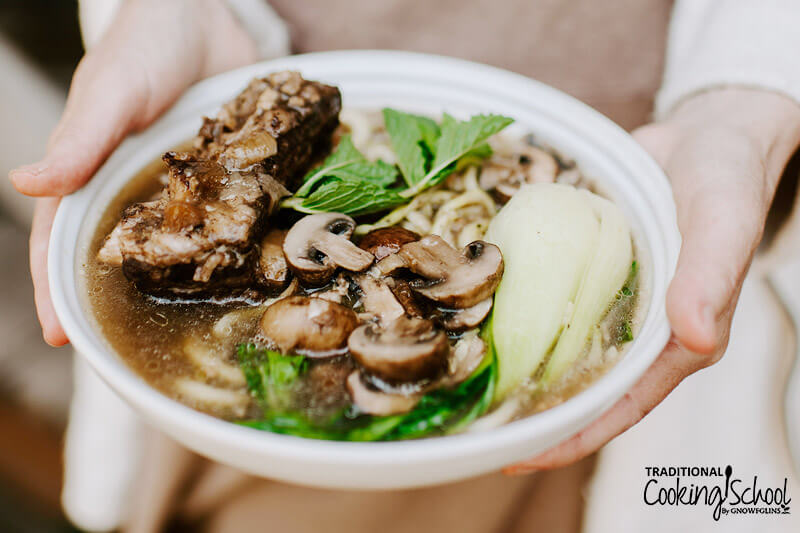
Megan: I actually put in a few bookmarks here when it came in the mail, so we have to look through.
Personally, I’m a big fan of stew, and so I’ve dog-eared a couple beef short rib recipes. I do personally love that, so there’s a couple.
There’s a beef short ribs with a white peach and apple chutney, which this has the most amazing stew base, so, even without the chutney, it’s just so good, and then, if you add the chutney, it really just becomes beautiful, colorful, great for kids, more for company, just special, but still easy. That’s one I love.
There’s another one with beef short ribs with this pho, so, in that one, I make vegetable noodles, and it has really this nice star anise. There are some really nice spices in the broth that give it a Vietnamese flavor, and, for each of these, I adapted them for the different diets.
So, like the pho spices, they’re completely exchangeable, so I get the AIP version, the VAD version, the GAPS version, so, if you hear a spice like, “Oh, I can’t have that,” you probably can because I’ve gone in there and for each diet said which spices to use.
Wardee: Nice.
Megan: That’s a nice one and very comforting. Let’s see what else we have here. There’s a nice breakfast mashed stew. I definitely tried to meet different flavor profiles, so there’s one where there’s different sweeter veggies that are smashed up, and it’s served with berries and ginger, so that’s a nice one.
Here’s a Japanese Udon soup. I worked in a Japanese restaurant as a sushi chef for many years up in Seattle… actually not many years, about… actually, about one year I think it was many years ago.
During that time, I learned some really traditional Dashis and broths that were used in Japanese cooking, and, here, I use daikon radish to make Udon noodles. I love this recipe because a lot of people are just used to making zoodles, and I’m passionate about daikon radish noodles.
They’re so good, and this is a really beautiful recipe. You can just use a poached egg on top, so not for AIP, but it’s just… It’s neat the variety that that soup offers and, again, super comforting.
I have a butter chicken, which is one of my favorites. You open the Instant Pot, and it’s just this incredible gravy that’s so delicious.
Then I have one more here that I bookmarked, and that’s the Thai chard bisque. This is an amazing blender-bisque soup made with a ton of fresh ginger, butter, green onions and green chard and then your broth, and it gets pureed, and then I like to drink it out of a mug.
It’s spicy because of the fresh ginger. It’s got a vibrant green, and then the butter makes it rich, and it’s just… It tastes healthy, but in a good way.
It’s just, again, slightly different than maybe what other people have had, and so, when you make it, it’s like, “Oh, what’s this?” Exciting and healthy all at once, so those are a few.
Wardee: I thought that was a good sampling because what really, really stood out to me from it was the variety. It’s like how can you get bored of soups when you, one, you’re drinking out of a mug. One is this like butter chicken that has a gravy, another one that’s like Vietnamese. When we did GAPS and I was like eating the same thing over and over, this is not that. This is variety and feasting.
Megan: Right. Yeah, and I have to say I’m as tired as anybody else at the end of the day, so, sometimes, I’ll ask my 10-year-old to get out the spiralizer and make me the daikon radish noodles because it’s the one thing that might break me at the end of the day. I don’t have the energy with the spiralizer now even though it only takes seven minutes.
Wardee: Yeah. Right. Right.
Megan: He loves that job, so, if you have someone else you can pull in on some of these, the recipes aren’t hard, but some take one more step or one less step, so, if you need to pull in that kiddo or that spouse to help you out, and, yeah, there’s just a lot of variety for sure.
Wardee: Nice, so, again, traditionalcookingschool.com/soupsandstews, where soups and stews is all one word, for the eCookbook package, and I’ll provide that link with this video. Also, I’ll provide a link to Amazon if you’re interested in the hardcopy (right here).
Wardee: Okay, Megan, now we’re to the point where we’re talking about your secrets because, in the cookbook, whether you have the hardcopy or the e-copy, Megan, these things are just amazing, she has seven secrets to tell you, and we can’t give them away, but I’m hoping you’ll talk them up, Megan.
The idea here is maybe I can say it in terms of when we did GAPS, and you said, when you did GAPS the first time, the soups were just… They got old. They’re greasy or it’s like, “We have to eat this again.”
If you know these secrets Megan is going to talk about and are shared in the book, you don’t have that feeling when you’re eating these nourishing, amazing soups and stews, so take it away, Megan.
Megan: Right. Okay, sure, so I’m going to share a little bit about secret number two, which is how to integrate fat into soups, and it’s a novel concept and one of the more novel ones because, usually.
When we think about fat and soup, we think about either a lot of fat in the soup because you’re making short ribs and just… It melts into the soup or, maybe at the saute stage, you’re using a tablespoon or two of butter to saute some onions or avocado oil or something, and so there’s a little bit of fat.
What we’re talking about here is a whole other way of using fat to affect the texture and how much the soup satisfies you, as well as to play into the flavor profile of the soup.
We’re talking about things that came from the GAPS diet as well as French cooking like using chicken skin. We’re talking about using pan drippings.
Finally, we’re talking about using something like schmaltz or bacon fat, even fats like roasted sesame oil and how to integrate those fats in larger amounts and why, so there’s actually a video that correlates to this secret.
It’s video number one, and it comes free with the cookbook. Any version, you buy it from free, and that’s about a 10-minute video where I’m in my home kitchen and I’m actually demonstrating for you how to integrate the fat in the soup, why, and which fat.
We actually build the soup together as I talk about that, and I consider it to be one of the most important amazing soup secrets that almost nobody does actually.
Wardee: Mm-hmm (affirmative), because, really, the fat can make or break a soup. Fat is the creaminess and flavor and smoothness and the whole satisfaction, but if your soup or stew is greasy, it’s like, “I don’t want to eat this,” so you really have to get it right.
Megan: Right. Right, and I call it that je ne sais quoi (“I don’t know what”), the same thing that sea salt adds. If someone can think they made a great soup, and then you taste it and it’s missing something or someone can feel like they really didn’t make a great soup, but they don’t know why, often, it traces back to one of those things.
How have you used salt, have you used enough, and how have you used salt, at what stages in the process, as well as the fat, how have you integrated it, how much, which fat have you used and at what stage, so both two things are so key to making that je ne sais quoi at the end of the soup where you taste it and you’re like, “Oh, my goodness, this is so good,” so, yeah.
Wardee: Nice, and I’ve eaten your soup, so I know you know what you’re talking about. They’re fabulous.
Megan: Thank you.
Wardee: I know I really need to step up my soup game, so this cookbook is coming in a good time for me.
Everyone, not to tease you too much, but the secrets are really worth learning.
Megan expounds on all seven of them including video for some of them with the cookbook, so follow the Amazon link to get a hardcopy (right here) or go to tradcookschool.com/soupsandstews, soups and stews is all one word, for the eCookbook package.
Is there anything else you want to say about the secrets, Megan?
Megan: No, I think there are the seven core secrets, and maybe, if I wanted to add one more thing, it’s just that there are more micro secrets like speckled throughout the whole cookbook and throughout the other videos.
There are seven big ones, but then I definitely found while I was talking in the videos that I would share more and more and more, and so I just encourage you to enjoy those videos, as well as all the fine print throughout the cookbook where I tried to integrate a lot more tips.
Wardee: Yeah. Right. That’s great, yeah, because you… When you’re following somebody’s recipe and when they do a good job like you have, you’re learning their technique as you do it and you’re like, “Oh.”
It often happens to me. Oh, it just made it so much better, and that’s because I did it this way instead of the way I usually do it, and, wow, I need to do it this way from now on.
Megan: Yeah, it’s so true.
Wardee: Okay, so I think the hardcopy package is pretty straightforward. It’s on Amazon. You can follow the link with this video (right here). It’s the hardcopy, and you get two bonus videos.
I want you to talk, Megan, now about the eCookbook package at tradcookschool.com/soupsandstews, because you’ve put together a more robust package off your website, so, if you would talk about that, what people will get when they go there and purchase?
Megan: Sure. You bet, so, within the cookbook, there are, and the videos, there are additional links, so, for example, the principles, so that one of the videos is about herbs, that links to a couple of printables where there are just additional materials.
So, one teaches which herbs to use for different ethnic dishes, so it gives a grid and equips you for that, and other pieces, the different nutrition in certain herbs, so those are principles that come with.
And then there are three additional videos that come when you buy the eCookbook, and so those are three additional recipes. There’s a nightshade-free Mole.
Mole has been a favorite of mine for a lot of years, but a lot of people can’t do either peppers or tomatoes or some of those spices, so I was inspired to share a low-inflammation version of Mole. Each of these additional recipes continues to teach and share the seven secrets, so that’s one of them.
One of them is an amazing fall-and-winter soup, which is just really classic, traditional, seasonal vegetables and herbs that are used throughout fall and winter, and it continues on soup secrets one and two from videos one and two.
Then the third is a Zuppa Toscana, which is a really well-loved Italian soup with sausage and beans and potatoes, and I give variations for each diet for each of these soups, so all of the diets can make them, with the exception of the Mole and GAPS intro, because there are actually a lot of GAPS intro recipes in the cookbook as well.
You get those free extra videos with their, I think, really nice benefit, and then, yeah, within the cookbook, there’s also the poaching guide, which teaches you how to poach meat, seafood, eggs and different kinds of meat in bisques and broths, so the poaching guide is a nice bonus.
There’s also additional tips about how to freeze and store your soups, and lots and lots of little addendum tips and guides, and those come actually in the back of the cookbook with links.
The nice thing about the eCookbook is it does link around, so you’re able to navigate within the cookbook really easily like you talked about earlier from the index or the table of contents, but also directly through my website or directly to principles from the eCookbook.
Wardee: Nice, so, to summarize, tradcookschool.com/soupsandstews is where you can get the eCookbook package, and so it has the E-version of Megan’s amazing soups and stews cookbook, and you actually get the PDF and the ePub.
It has all the soups and stews recipes for all those special diets. There’s the poaching guide, the seven secrets, and just tips throughout, and the five videos, and so the total package.
I just want to go over this so all of you can see the value here, but Megan put together those really informative and fun videos, plus the two versions of the eCookbooks so you’re actually getting a package that’s worth $45, but she’s offering you, what is it, 55% off for a limited time, so definitely take advantage because, really, you’re getting all of that for just $20.
It’s a wonderful deal, a wonderful investment to make especially if you’re on a healing diet, but, as Megan was saying, for anybody, just to have a beautiful, amazing soups and stews that you’re like, “Wow, this is incredible,” you just won’t regret the purchase.
Plus, you’re supporting Megan and her family, which is just a really nice thing to do because Megan does beautiful work.
Megan: Thank you.
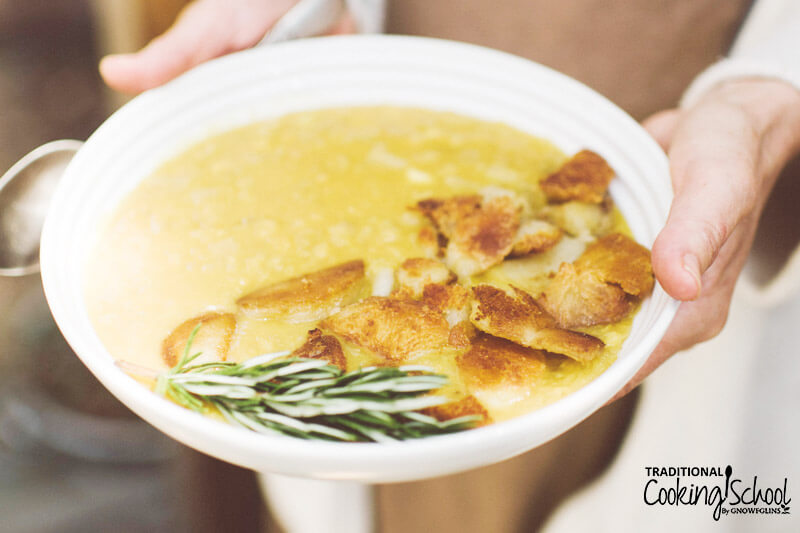
Wardee: You will see links with this video to purchase the eCookbook package on Megan’s site (right here). If you do want a hardcopy, then follow the link to Amazon to get that (right here).
All right, Megan, is there anything else you want to share before we go?
Megan: I guess just I put my heart into this for all of the readers. Really, that was what was behind this the whole time, so I’m actually even available by email if someone had a question.
More than anything, it was written as a way to help people to make easy, delicious, amazing soups to help them on their wellness diet, so I’m available to you.
That’s why I did this, and I hope it will serve people as it was intended. I hope it will be beautiful and something you want to snuggle up with, but also something that really serves people’s needs.
Wardee: I know it will be. Thank you for pouring your love and three years of all your little snatches of extra time, and thank your family, too, because, boy, of course, they’d been feasting, but they’ve tasted a lot of recipes, haven’t they?
Megan: Yes. Yes, for sure.
Wardee: I just want to know, what’s your husband’s favorite recipe?
Megan: That’s a fun question.
Wardee: I’m surprising you with that one, if you know off the top of your head?
Megan: I’m leafing through to try to-
Wardee: What about one of your boys?
Megan: I’m so in touch with what I’m passionate about that I could tell you, like I did earlier, six of my favorites.
Wardee: Yeah. Right.
Megan: Let’s see.
Wardee: What about one of the boys?
Megan: Yep, they all love the mashes I do, and so there’s this savory breakfast mashed stew with sausages, and so, depending on the diet you’re on, this one is for all the diets. There are different vegetables that are basically made into what is like a mashed potatoes, but with a bone broth or meat-stock base, so winter squash for GAPS, sweet potato for AIP. It’s different, depending on the diet, and then I think it’s served with sauteed onions and fried sausages and, possibly, a big dollop of butter on top of the mash, so that’s… I mean, that’s just classic comfort food.
Wardee: Sure.
Megan: I put that in the soup category because you can make the mashed potatoes a little looser and more stew-like or thick, depending on how you want, either way we’re using a really good fat and bone broth in the base of the mash, whom you’re serving that big, hearty bit of basically meat and mashed potatoes.
Wardee: Oh, yeah, I can see how that would totally appeal to the guys in your life.
Megan: Yeah. Exactly.
Wardee: They’re working hard or throwing baskets hard, and they just need just… Give me a meal.
Megan: Yeah. Exactly.
Wardee: Yum. Okay, I get it. I get it. Thank you for your time, Megan. This has been so fun, and I hope for all of you that have been tuning in, listening to us that you can benefit from Megan’s wonderful work now or in the future by getting her cookbook, and be sure to keep in touch and let me and Megan know what recipes your family loves, and, as Megan said, she’s available for questions, too.
Megan: Yes. Thank you, Wardee. This was my pleasure.
Wardee: Thank you, Megan. Bye-bye, everyone. God bless you all.
Want to hear more from Megan?
- Diagnosed With 5 Serious Health Conditions By Age 40, Now Healed! {Megan’s Story}
- How The Word “Alternatives” Turns Gut-Healing Foods Into Feasts
- EatBeautiful.net
How do you make amazing soups? Do you have any secrets to share?
If you’re on a special diet like GAPS, AIP, or Paleo, you know it can get boring. You feel like you’re eating the same old soup day after day, right? Yet… what if I told you there are simple ways (and easy recipes) to make amazing soups and stews that are highly nutritious with practically limitless variety? There’s a way!!! Click to learn more about my friend’s new cookbook with 80 delicious, healing soup and stew recipes, plus 7 soup-making secrets to up your game!
We only recommend products and services we wholeheartedly endorse. This post may contain special links through which we earn a small commission if you make a purchase (though your price is the same).

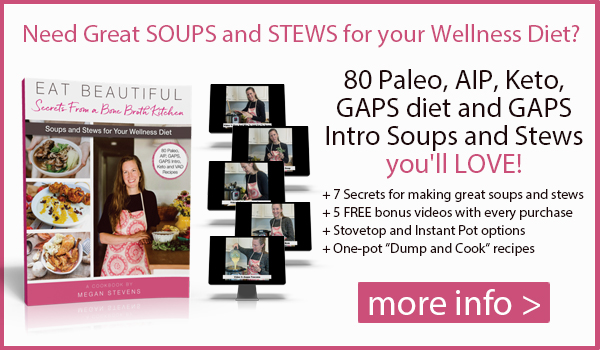

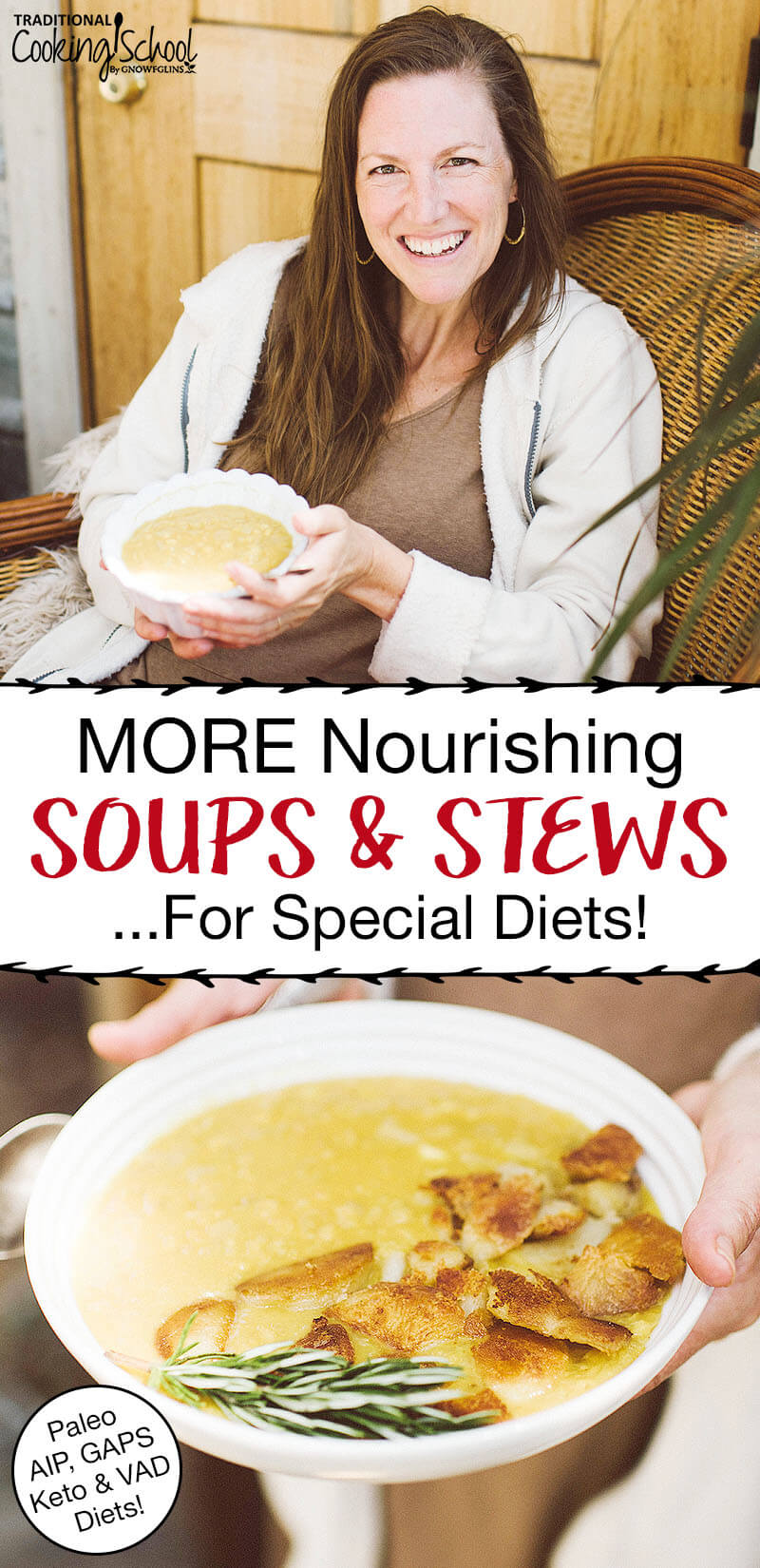
The Soup looks beautiful and tasty, I would definitely gonna try out, thanks for sharing 🙂
Start with homemade, fatty broth, every soup will be a winner! No brainer. Great for the best cooked grains too. Always salt your dishes or pasta/grains at the start, so it cooks into the food. I make a kasha with chicken broth that starts by toasting the kasha in an egg to coat it before putting in simmering broth. No more mush. Beautiful kasha, for pilaf add onions & garlic fried in bacon fat and toasted nuts, oh WOW.
Wow, this looks amazing! I love soup, but my family – especially my children – aren’t such fans. Maybe this would change their minds! I do have a question: my family doesn’t do well with lots of fat, even healthy fats. While it’s something we’re working on, I am wondering if there are large quantities of fat in the soups, or if it is just a little bit that makes a big difference? Thanks for any information you can give me!
Hi Kristy, this is Megan. 🙂 Does your family not like fat, or do they have a problem digesting it (as in gallbladder and bile issues)? If it’s the former, then the technique I use of blending fats into soups very much makes any fattiness go away. Instead, fat makes the soups’ textures better. However, you can also certainly reduce fats in any soup, by just using less. If you ever have a question about a specific recipe, you can certainly email me directly, and I am happy to adapt it for your family. Thank you! ([email protected])
Thank you for the reply, Megan, and for the help. We have trouble with fats (with the exception of coconut oil) causing digestive upsets and other health issues. I know nutritious soups are so helpful for improving digestion and healing gut issues, so I try to incorporate them into our diet as I can. As long as the amount of fat can be reduced to meet our needs, it should be ok. I’m hoping to purchase your book soon! Thanks again!
nice